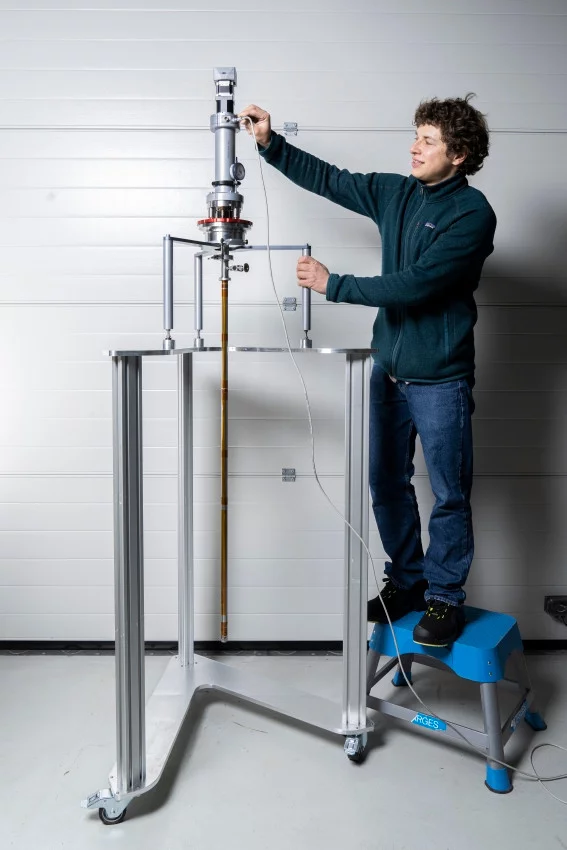A new in situ uniaxial pressure cell at Paul Scherrer Institute PSI gives scientists unrivalled control to tweak quantum materials microscopically while directly observing the effects on the material properties with X-ray scattering, neutron scattering or muon spin spectroscopy.
One of the most appealing features of quantum materials for future technological applications is tunability: the ability to manipulate quantum phenomena such as superconductivity in the material via an external parameter. This valuable quality results from the delicate interplay between various atomic interactions that exists in such materials, which allows the system to be nudged into one state or another.
There are different ways to ‘nudge’ a quantum material. It is well known that superconductors have to be cooled down to a very low temperature to begin their special behaviour of zero resistance. Magnetic fields are also a popular way to tune a quantum material as, like temperature, they are highly controllable. Pressure is another such parameter that can be used to tune a quantum material, potentially giving access to a much larger energy range than magnetic fields. In particular, pressure often enables superconducting materials to superconduct at less cold temperatures – and, in some cases, even close to room temperature. Yet applying it in a controlled manner is extremely difficult.
Now, a new uniaxial pressure cell built by the Laboratory for Neutron and Muon Instrumentation at PSI is changing that. “Before, you essentially just took a hammer and saw where you ended up. If you were lucky you ended up on the baize. Now it’s more like you have a billiard stick – you have control to push it to where you want it,” says Daniel Mazzone, instrument scientist at the Swiss Spallation Neutron Source SINQ, who studies materials under uniaxial compression and is looking forward to using the device for his research.
The new device enables scientists to use pressure to tweak the atomic interactions in quantum materials in a highly controlled manner in situ while simultaneously probing the resulting quantum phenomena using X-ray scattering, neutron scattering or muon spin spectroscopy.
Delicate squashing, super-duper control
A note about squashing: we are not talking about stamping on a ripe tomato. In some cases, crystals are compressed by about 0.01% uniaxially (top to bottom or left to right) - the equivalent to squashing a large tomato by the width of a hair.
This tiny compression is applied incredibly gently and accurately. It takes about one minute to compress a crystal the size of a tomato seed by about twenty microns. This twenty-micron compression is spread over forty thousand steps, giving a high degree of control over the pressure.
“Only through a collaborative effort can we do such things”
Achieving such awesome pressure control required innovative engineering solutions. Gediminas Simutis, scientist in the Laboratory of Neutron and Muon Instrumentation who led the instrument development, believes that this was uniquely possible because of vibrant interactions between engineers and scientists at PSI. “Only through a collaborative effort can we do such things,” he says.
The engineering solution that would meet science’s strenuous demands, designed by Alex Bollhalder (Laboratory for Neutron and Muon Instrumentation/ Mechanical Engineering, PSI), uses a rotor motor with micro-stepping capability that switches into linear motion. This means that a lot of travelling of the motor results in very little squashing. Even this could still result in too much applied force; thus the engineering team complemented it with a series of springs to apply the force very softly.
A resource for both Swiss and European research communities
The in situ nature of the uniaxial pressure cell - designed to fit within a cryostat and enable external pressure control - is an unusual feature. This, combined with the high level of control, will make it a major resource to users at SINQ for investigations into materials such as Mott insulators, metals that host skyrmions, quantum magnets and cuprate superconductors. “Currently, within its user programme, SINQ is renowned for its defined control over magnetic field. Now with uniaxial pressure, we hope to be able to go in same direction,” comments Simutis.
Aiming to be transferable between different instruments, techniques and samples, the pressure cell was developed in collaboration with University of Zurich, University of Chalmers in Sweden and DESY Synchrotron in Hamburg, Germany. Currently enjoying a sojourn in Hamburg at the PETRA III synchrotron, the device will also serve European research communities, particularly at the European Spallation Source in Sweden.
Contact
Dr. Gediminas Simutis
Sample Environment Group
Paul Scherrer Institute PSI
+41 56 310 32 69
gediminas.simutis@psi.ch
Original Publication
-
Simutis G, Bollhalder A, Zolliker M, Küspert J, Wang Q, Das D, et al.
In situ uniaxial pressure cell for x-ray and neutron scattering experiments
Review of Scientific Instruments. 2023; 94: 013906 (7 pp.). https://doi.org/10.1063/5.0114892
DORA PSI

